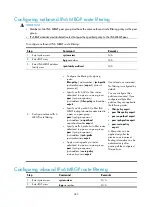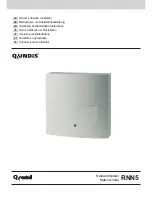
409
Router port(s):total 1 port(s).
Eth1/1 (D) ( 00:01:30 )
IP group(s):the following ip group(s) match to one mac group.
IP group address:FF1E::101
(::, FF1E::101):
Attribute: Host Port
Host port(s):total 2 port(s).
Eth1/3 (D) ( 00:03:23 )
Eth1/4 (D) ( 00:04:10 )
MAC group(s):
MAC group address:3333-0000-0101
Host port(s):total 2 port(s).
Eth1/3
Eth1/4
The output shows that Ethernet 1/3 and Ethernet 1/4 of Switch A have joined the IPv6 multicast group
FF1E::101.
Static port configuration example
Network requirements
As shown in
, MLDv1 runs on Router A, and MLDv1 snooping runs on Switch A, Switch B, and
Switch C. Router A acts as the MLD querier.
Host A and host C are permanent receivers of IPv6 multicast group FF1E::101. Ethernet 1/3 and Ethernet
1/5 on Switch C should be configured as static member ports for multicast group FF1E::101 to enhance
the reliability of multicast traffic transmission.
Suppose STP runs on the network. To avoid data loops, the forwarding path from Switch A to Switch C
is blocked under normal conditions, and IPv6 multicast traffic flows to the receivers attached to Switch C
only along the path of Switch A—Switch B—Switch C. For more information about the STP, see
Layer
2—LAN Switching Configuration Guide
.
Configure Ethernet 1/3 on Switch C as a static router port, so that IPv6 multicast traffic can flow to the
receivers nearly uninterruptedly along the path of Switch A—Switch C in the case that the path of Switch
A—Switch B—Switch C gets blocked.
NOTE:
If no static router port is configured, when the path of Switch A—Switch B—Switch C gets blocked, at least
one MLD query-response cycle must be completed before the IPv6 multicast data can flow to the receivers
along the new path of Switch A—Switch C. Namely, IPv6 multicast delivery will be interrupted during this
process.
















































